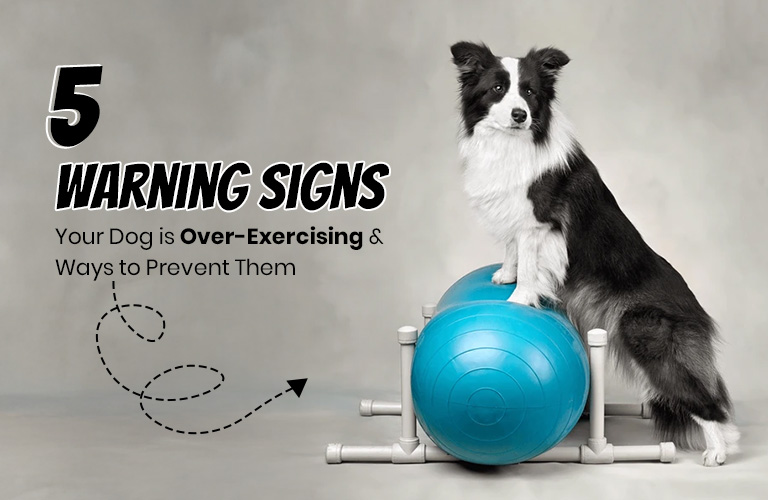Survival of the fittest, as it is rightly said, is true for both humans and animals. Our beloved furry companions also need regular exercise, a balanced diet, adequate rest and lots of love to stay fit in the long run. But, everything in moderation reaps the best results. When talking about exercise, pet parents at times end up overdoing it without realizing the consequences.
In this blog, we will discuss the symptoms of over-exercising along with ways to prevent them so that you can keep your canine in the pink. Before jumping into this, let’s first have a look at the benefits of regular exercise in dogs.
Top 5 symptoms of over-exercising in dogs
Here are 5 common signs that indicate a dog is over-exercised:
- Changes in behavior: Over-exercising can make your canine feel exhausted, both mentally and physically, which is often seen in their behavior. If you notice changes in the way they behave, such as reluctance to play or exercise, excessive barking, frequent panting, irritability, crankiness, etc., it can be an indication of over-exercising and they need to slow down.
- Sore or torn paw pads: When it comes to running and playing, puppies especially forget when to stop since they enjoy indulging in these activities. However, it is essential to limit this fun as it can cause wear and tear of paw pads and may cause bleeding, soreness, blisters, pus, pain and discomfort. Sore or torn paw pads are one of the major indicators of over-exercising in puppies. Consider making your dog wear dog shoes and applying a pet-friendly paw balm.
- Limping or stiffness: Dogs experience limping, joint stiffness, muscle soreness and other joint-related issues soon after excessive physical activities. These signs are often accompanied by struggling to climb stairs, reluctance to jump, difficulty walking, whining while moving, etc.
- Heat exhaustion: Heatstroke or heat sickness is a common indicator of over-exercising dogs during summer, especially if they are dehydrated or exercising outside for a longer duration. Overheating can lead to breathing difficulty, getting tired quickly, excessive sweating, red gums, etc., and can be life-threatening if left unattended. So, make sure you take plenty of breaks during exercise and keep your dog hydrated by providing access to cool drinking water at all times.
- Fatigue or lethargy: Feeling a little tired after exercise or any physical activity is pretty normal, but if your beloved companion feels lethargic or fatigued for prolonged hours post-exercise, it denotes their over-exertion. They may seem disinterested in playing, walking or other routine activities when they have over-exerted themselves. Consider reducing their exercise time or stopping it for some time to help them recover properly.
Prevention tips for overexertion in dogs
Let’s have a quick rundown on a few simple tips that help prevent overexertion in dogs:
- Adequate rest: Offering adequate rest and hydration ensures better muscle recovery and increased energy for your furry companion. Make sure you allow them to rest properly post-exercise to prevent exhaustion.
- Consider age & breed: Every dog breed is unique and so are their exercise requirements. While some breeds require heavy exercise, others need moderate activity. Consider the age and breed of your canine companion and set an appropriate exercise routine accordingly and prevent over-exercising.
- 5-minute rule for puppies: A good rule of thumb to prevent puppies from over-exerting is to make them exercise 5 minutes per month of their age. For instance, a 4-month-old puppy should get 20 minutes of exercise a month.
- Keep an eye on symptoms: Be aware of the symptoms of over-exertion. If you notice your pooch extremely tired, cranky, reluctant to play, etc., do not force them and allow them a break to restart with energy.
- Weather conditions: Outside temperature and atmosphere also play a major role in determining the amount of exercise your dog needs, especially for outdoor exercises. Exercising or even walking in the scorching sun may heat your dog’s body faster and lead to heatstroke. Hence, minimize their outdoor timings in the summer to prevent them from getting tired quickly.
- Regular vet visits: Over-exercising may sometimes lead to serious health issues, including hip dysplasia, hyperthermia, etc. Therefore, taking your little one for routine vet visits can help detect any potential disease at an early stage and treat it in time.
Keep your canine fit and healthy
A healthy pet is a happy pet and one of the biggest contributors to keeping your four-legged companion in good trim is regular exercise. Although exercise on an everyday basis is recommended to ensure the vitality of your pooch, over-exercising them may result in multiple health issues that can be life-threatening.
Remember, the best way to maintain your pet’s fitness is through striking a balance between moderate exercise and adequate rest. Equip yourself with the information provided in the blog to prevent your pooch from over-exerting itself and keep it hale and hearty in the coming years. Do not forget to consult the veterinarian in case you notice any unusual symptoms.



